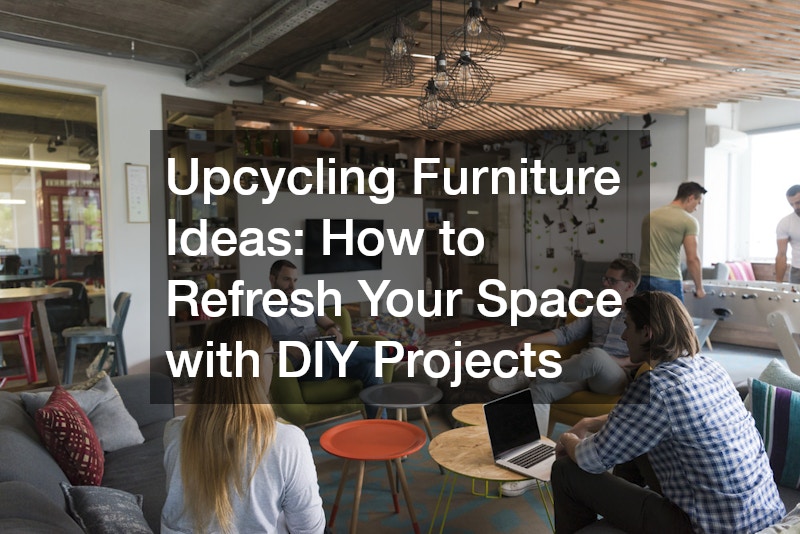Introduction
Upcycling furniture ideas provide homeowners with a budget-friendly, eco-conscious approach to interior design. Instead of discarding old or unwanted furniture, many people are now opting for DIY projects that refresh these pieces, enhancing their home’s aesthetic. This trend is not only a cost-effective home improvement solution but also a way to add a personal touch to spaces. By repurposing furniture, homeowners can reduce waste, contribute to sustainability, and enjoy unique decor that reflects their style. Throughout this article, we’ll explore various upcycling furniture ideas, tools, and techniques to inspire your next home project.
1. Why Upcycling Furniture is the Perfect Solution for Homeowners
Upcycling furniture offers an incredible opportunity for homeowners to save money while still achieving a fresh, modern home aesthetic. Unlike purchasing new items, which can be costly, repurposing existing furniture is a budget-friendly method that allows for creative expression. Engaging in DIY furniture projects not only helps to conserve financial resources but also permits individuals to customize their interiors based on specific preferences and requirements. This approach to home improvement is not only economically sound but also immensely satisfying as it combines creativity with practicality. For those on the lookout for affordable home improvement tips, upcycling is an invaluable resource.
Embracing upcycled furniture ideas significantly contributes to decreasing environmental impact. The process of repurposing furniture reduces the need for new materials and lowers the amount of waste sent to landfills. By integrating sustainable practices into home decor, homeowners align with eco-friendly values, promoting waste reduction and environmental conservation. Green home solutions, such as using upcycled decor, align with global efforts toward sustainable living. Therefore, upcycling serves not only as a perfect individual choice but also as a step towards a broader global commitment to environmental responsibility.
Moreover, upcycling furniture transforms ordinary spaces by introducing unique, tailor-made pieces. It enables homeowners to innovate and personalize each piece of furniture, thereby adding a creative flair and individuality to their homes. These customized projects are a canvas for self-expression, allowing every nook and cranny of a house to be an extension of personal style. Whether remodeling an old coffee table or reimagining a bookshelf, the upcycling process does more than just recycle materials; it invigorates spaces with originality and charm. By opting for customized furniture, homeowners craft interiors that resonate with personal stories and aesthetic values.
2. Essential Tools and Materials for Upcycling Furniture
Embarking on an upcycling journey requires a fundamental set of tools, all of which contribute to the transformation of old to gold in the realm of furniture. First, essential items like sandpaper and paintbrushes prepare surfaces for new colors and coatings. A staple gun, hammer, and screwdriver are crucial for assembling and reinforcing components. Additionally, having a home workshop stocked with saws, measuring tapes, and protective gear ensures a smooth project execution. Amassing these upcycling tools equips homeowners for any DIY project, turning the household into a hub of creativity and design.
Choosing the appropriate paint, stains, and finishes is vital to the success of any upcycling project. Furniture paint comes in a wide array of colors and textures, customized to fit different materials like wood or metal. Meanwhile, stains enhance natural wood grains, and protective finishes ensure durability against wear and tear. Selecting the right product depends on the item and the desired end result, so it’s crucial to explore different options. For more in-depth advice, consulting a guide on choosing paint for DIY projects can be advantageous, ensuring each application is both efficient and aesthetically pleasing.
Incorporating decorative accessories brings an additional layer of personality and charm to upcycled furniture. Knobs, fabric, and trim can be instrumental in redefining the look of a piece, transforming furniture into centerpieces that capture attention. Whether adding quilted fabric to a chair or vintage knobs to a dresser, these accents let homeowners infuse character effortlessly into their decor. This approach not only revitalizes old designs but also fosters creativity in making every room feel uniquely styled. By embracing decorative accents, individuals can transcend conventional decor ideas, crafting spaces that echo personal tastes and innovation.
3. Upcycling Furniture Ideas for Every Room in Your Home
A. Living Room Upcycling Ideas
Transforming an old coffee table into a modern centerpiece is a rewarding venture for any living room. Begin by sanding and painting the surface, or consider adding tiles or a sheet of glass for additional elegance. These alterations not only rejuvenate the table but also convey a certain sophistication, perfectly aligning it with contemporary interior themes. Through this upcycled decor project, a seemingly worn-out item receives new life, becoming both functional and visually appealing. By repurposing ordinary coffee tables into conversational pieces, homeowners both innovate and inspire within their personal spaces.
Another exciting living room project is reinventing an outdated bookshelf by repainting or adding decorative backing paper. By introducing vibrant colors or patterned paper, bookshelves transition from functional storage to striking displays. This process involves withdrawing the contents, refinishing, and then reassembling items to highlight decorative elements. As a DIY shelving initiative, this allows homeowners to showcase books, trinkets, or art in a curated setup. Such furniture upcycling projects ultimately provide a refreshing facelift to tired furniture, making them integral elements of a stylish living space.
B. Bedroom Upcycling Ideas

Upcycling your bed frame offers a transformative opportunity to align bedroom decor with individual style. Through painting or upholstering, an old bed frame can receive a rebirth, harmonizing with the room’s palette and themes. This project requires a thorough approach where fabric patterns are assessed and colors carefully selected. Such a refurbishment adds elegance and sophistication to a bedroom while utilizing existing resources. Interested individuals can explore additional bedroom renovation ideas to create a cozy, personalized space tailored to their aesthetic and functional needs.
The transformation of an old dresser or nightstand is another creative endeavor in bedroom upcycling. With the application of chalk paint or the installation of new hardware fittings, these pieces morph into focal points of personality in any room. By opting for bold color choices or intricate designs, the furniture reflects personal style and trends. This process not only renews old items but also diversifies the bedroom’s atmosphere with fresh and vibrant decor. Through dresser transformation, homeowners innovate while maintaining the character and history of original furniture items.
C. Dining Room and Kitchen Upcycling Ideas
Upcycling dining chairs through reupholstery brings comfort and style into the dining room environment. By infusing new fabric choices and adding padding, chairs are refreshed into chic seating that enhances any meal setting. This DIY dining room idea requires selecting durable and appealing materials that withstand wear. The process empowers homeowners to craft cohesive dining sets that unify the themes or color patterns of their spaces. With these kitchen furniture makeovers, individuals maximize both visual appeal and functionality, optimizing home dining experiences.
Repurposing kitchen cabinets or cupboards with paint and open shelving updates and organizing culinary spaces with innovation. This task involves removing doors, adding new color schemes, and installing open units to showcase kitchen essentials or decorative items. Such transformations revive outdated cabinets, injecting modernity and simplicity into kitchens. Through this approach, homeowners craft kitchens that are not only functional but aesthetically resonate with clean, modern lines. This DIY cupboard idea exemplifies how kitchen upcycling projects elevate interior designs through practical and stylish reinventions.
D. Outdoor and Patio Furniture Upcycling

The conversion of old wooden pallets into outdoor seating creatively integrates functional designs with cost-saving strategies. Constructing benches or tables from pallets utilizes natural resources that are often discarded, harmonizing with garden settings organically. This garden furniture project involves assembling pallets into designated configurations, followed by sanding and finishing to ensure durability and comfort. Such outdoor DIY furniture encapsulates the spirit of upcycling: utilizing readily available materials to craft innovative, appealing items perfect for leisure spaces. These pallet upcycling ideas not only optimize utility but also foster eco-friendly home practices.
Repainting and refinishing wicker or metal furniture for outdoor arrangements revitalizes patios or garden areas, extending the life of these items. Utilizing specialized outdoor-friendly paint adds protection against elements while introducing pops of color or fresh tones. This wicker furniture makeover demands stripping old paint, applying primer, and finishing with chosen hues, ensuring outdoor pieces with style and resilience. The undertaking underscores the value of preserving pre-existing items, reinforcing sustainable creativity within home improvement endeavors. Patios infused with upcycled furniture shine with both vibrancy and resourcefulness.
4. Simple Steps to Get Started with Upcycling
For newcomers to upcycling furniture, starting small can ease the learning curve and foster necessary skills. Tackling projects involving stools or side tables provides experience without overwhelming complexity, encouraging experimentation with upcycling furniture ideas. These easy DIY projects help beginners understand the diverse techniques involved in furniture transformation. Additionally, these smaller projects serve as a gateway to larger endeavors once confidence is established. By honing skills through manageable tasks, individuals can gradually refine their abilities, readying themselves for more intricate challenges.
Planning and visualizing designs are paramount steps in ensuring successful upcycling outcomes. Crafting mood boards or sketches prior to initiating projects enables an informed and guided approach to refurbishments. This process helps homeowners clarify their vision and coordinate design elements effectively, avoiding mismatched concepts or unfinished projects. Well-thought-out design planning fosters creativity while also providing structured project guidelines. Creators can accurately anticipate the end result, leading to satisfying and cohesive furniture makeovers that accomplish initial design intents.
Proper furniture preparation—particularly cleaning, sanding, and priming—forms the backbone of any successful upcycling initiative. Neglecting these preliminary stages can lead to unsatisfactory finishes, as unkempt surfaces hinder paint or stains from adhering properly. Effective sanding techniques ensure smooth bases for new coatings, while priming seals and protects materials from damage. Cleaning is equally crucial, ridding pieces of grease or residues that compromise final results. Implementing thorough furniture preparation underscores the essential nature of groundwork in achieving polished projects.
5. Common Mistakes to Avoid When Upcycling
One frequent pitfall in upcycling furniture projects is bypassing the necessary prep work, which could jeopardize the finish quality. Skipping steps like sanding or priming often result in uneven surfaces and peeling paint, diluting the transformative potential of the endeavor. Proper furniture preparation is a pivotal component, as it prepares items for new applications. Painting tips emphasize the importance of dedication to foundational work and setting up projects for enduring success. Ensuring attention to detail in these initial stages is key to crafting beautiful, long-lasting pieces.
Selecting the wrong paint or materials can hinder the efficacy and appearance of upcycled furniture. Matching paint type to the material—be it wood, metal, or fabric—is critical in ensuring durability and aesthetic alignment. Not all products are universal, and furniture materials vary in compatibility, so research should precede product selection. Comprehensive understanding of painting techniques and material responses can mitigate issues with peeling or fading finishes. Armed with this knowledge, homeowners can confidently execute projects with functional and decorative success.
Failing to measure accurately can lead to mismatched components or material misuse, complicating upcycling plans. Accurate measurements are indispensable for tasks such as cutting fabric or installing new hardware fitting. This mistake typically results from impatience or oversight, leading to unsatisfactory results. Measurement tips advocate for meticulous assessments, guiding each project step precisely toward envisioned outcomes. Proper planning and careful measurements ensure seamless integration of elements into finalized projects, balancing design and function perfectly.
6. Upcycling Furniture for Homeowners: Long-Term Benefits
One of the most appealing advantages of upcycling furniture is the potential to increase home value through enhanced aesthetic appeal. Property buyers often appreciate the character and uniqueness of upcycled decor, which can set a home apart in the real estate market. Customized, sustainable designs resonate well with modern preferences for eco-friendly living spaces, further attracting prospective buyers. By investing time and creativity into repurposed items, homeowners not only enjoy personalized interiors but potentially see increased property value. Such home decor ideas underpin the transformational power of thoughtful, individualized aesthetics on market appeal.
Moreover, upcycled furniture frequently surpasses mass-produced items in terms of durability and build quality. Many traditional furniture pieces boast robust constructions that, once refurbished, offer longevity superior to new, cheaper alternatives. Quality furniture restoration transforms seemingly discarded pieces into long-lasting staples within homes, marrying the strengths of original craftsmanship with modern design aspirations. Committing to durable home decor through upcycling grants homeowners items that withstand life’s challenges while maintaining charm. By transforming old into new, individuals ensure sustainable, stylish, and long-lasting contributions to their living environments.
Additionally, upcycling fosters a rewarding sense of satisfaction derived from creativity and resourcefulness. The process of turning unwanted furniture into something new and functional fulfills both practical needs and personal growth. This approach nurtures ingenuity and cultivates an appreciation for sustainability and design, enriching daily life. Those who engage in upcycling projects discover a profound connection to their home, where each piece tells a story marked by innovation and care. Such endeavors provoke a sense of accomplishment unmatched by store-bought solutions, reinforcing the art of making something truly one’s own.
Conclusion
In summary, upcycling furniture offers a wealth of benefits for homeowners, from environmental sustainability and cost savings to customizable design solutions. Undertaking DIY home decor projects invites creativity, allowing individuals to personalize and refresh living environments affordably. Embracing upcycling encourages a mindset focused on the art of repurposing ideas and materials, leading to impactful and creative decor. By starting with simple concepts and exploring different styles, readers can embark on a journey of turning the ordinary into something extraordinary. The satisfaction gained from breathing new life into old furniture underscores the true value of these transformative endeavors.
